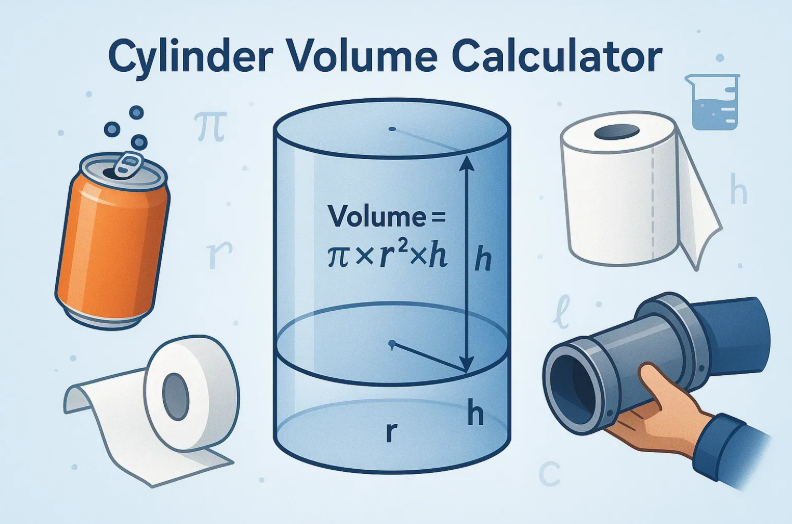Ever looked at a soda can and thought, “How much stuff fits inside this thing?” You were thinking about cylinder volume—even if you didn’t know it. Whether you're dealing with water tanks, engine parts, or a simple can of soup, knowing how to calculate the volume of a cylinder isn’t just school trivia. It’s real-world useful.
What Is Cylinder Volume?
A cylinder is a three-dimensional shape with two identical, perfectly round ends (called bases) and one continuous side that connects them. Think soda can, paper towel roll, or industrial pipe. The volume of a cylinder refers to how much space is enclosed inside—in other words, how much it can hold.
In mathematical terms, a cylinder’s volume depends on two things:
-
The radius (r) of its circular base
-
Its height (h) from base to base
Try out Hollow Cylinder Volume Calculator
How to Calculate Cylinder Volume (Step-by-Step)

Now that you know the formula for cylinder volume is:
Volume = π × radius² × height
1. Measure the Radius: The radius is the distance from the center of the cylinder’s circular base to its edge. If you’re given the diameter (the full width), simply divide it by 2 to get the radius.
Example: If the diameter of a can is 10 cm, then the radius is 5 cm.
2. Measure the Height: This is how tall the cylinder stands, from one circular base straight up to the other. Just make sure it’s a straight, vertical measurement.
Now it’s time to calculate. Just square the radius (multiply it by itself), then multiply that by the height, and finally multiply the whole thing by π (approximately 3.1416).
Example: You have a metal pipe with a radius of 4 inches and a height of 12 inches.
Step 1: Square the radius → 4 × 4 = 16
Step 2: Multiply by height → 16 × 12 = 192
Step 3: Multiply by π → 192 × 3.1416 ≈ 603.19 cubic inches
That’s the volume of space inside the pipe.
Try out Capsule Volume Calculator
How Archimedes Figured It Out
Let’s rewind a couple of thousand years—ancient Greece, around 250 BCE. A mathematician named Archimedes was in his bath when he made one of the most famous discoveries in science. Legend says he got so excited, he jumped out of the tub and ran naked through the streets shouting “Eureka!” (which means “I’ve found it!”).
What did he find?
Not exactly how to calculate the volume of a cylinder—but something related: how to measure the volume of irregular objects using water displacement.
The story goes that King Hiero suspected his goldsmith of cheating—mixing silver into a supposedly pure gold crown. Archimedes was asked to figure out if the crown was solid gold without melting it down. That’s when the bath moment happened. He noticed the water level rising as he got in, and realized: the amount of water displaced equals the volume of the object submerged.
It wasn’t the cylinder formula, but it was a breakthrough in how volume can be measured physically—a foundation for the very concept we now apply with geometry.
And here’s the fun part: Archimedes did go on to study volumes of geometric solids, including spheres and cylinders. In fact, he considered one of his greatest mathematical achievements to be his discovery that:
“The volume of a sphere is exactly two-thirds the volume of the cylinder that contains it.”
He was so proud of it that he asked for a sphere and a cylinder to be engraved on his tombstone. That’s how tightly this idea—volume, shape, space—was woven into his life.
Check out Math section to solve math quick and easy

